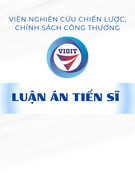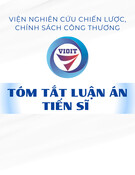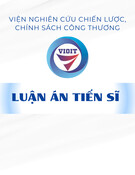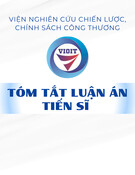THE UNIVERSITY OF DA NANG UNIVERSITY OF ECONOMICS
VO VAN CUONG
STUDYING THE EFFECT OF CORPORATE GOVERNANCE ON THE EXTENT OF CORPORATE SOCIAL RESPONSIBILITY DISCLOSURE OF LISTED ENTERPRISES IN VIETNAM
SUMMARY OF DOCTORAL THESIS
DA NANG – 2021
The thesis is completed at UNIVERSITY OF ECONOMICS - THE UNIVERSITY OF DA NANG Supervisors: Assoc. Prof. Doan Ngoc Phi Anh Assoc. Prof. Tran Dinh Khoi Nguyen
Reviewer 1 ………………………………………………………… Reviewer 2 ………………………………………………………… Reviewer 3………………………………………………………… The thesis shall be defended in front of the thesis defense committee meeting at University of Economics – The University of Da Nang at December 02, 2021
This thesis is available at: - The National Library - The Center for Learning Information Resources and Communication - University of Da Nang
1
INTRODUCTION
1. The necessity of the research
In the past few decades, many companies have been recognized for contributing to the advancement of economy and technology but have been criticized for creating social problems such as pollution, waste, and exhausted resources, product quality and safety, rights and status of workers ... In that context, the need for businesses to be more responsible to the society is increasingly focused. Corporate social responsibility (CSR) has attracted much international attention and is increasingly focused in Vietnam. Therefore, the research on CSR disclosure is also carried out by many studies and viewed in many different aspects, including research on the influence of corporate governance (CG) to the extent of CSR disclosure.
In the world, most of the researches on the influence of CG on the level of CSR disclosure only studies separately the effect of CG characteristics (see Ali and Atan, 2013; Frias-Aceituno et al., 2013; Giannarakis, 2014; Majeed et al., 2015; Rahman and Ismail, 2016…) or CG quality (see Chan et al., 2014). There has not been a comprehensive study on the effect of both CG characteristics and CG quality on the extent of CSR disclosure. On the other hand, researches on CSR disclosure often focus on voluntary information (see Juhmani, 2013; Sweiti and Attayah, 2013; Lan et al, 2013 ...) rather than being concerned with information that is published mandatorily in each country.
In Vietnam, research on the effects of CG on CSR disclosure is quite rare, and to the extent of the author's knowledge, there has been no study. For CG research, recent studies have focused only on CG characteristics (see Le Minh Toan and Gordon Walker, 2008; Nguyen
2
Truong Son, 2010; Duc Vo and Thuy Phan, 2013; Doan Ngoc Phuc and Le Van Thong, 2014; Nguyen Trong Nguyen, 2015 ...) or have just researched the quality of CG (see Hoang Van Hai, 2016), there is no comprehensive study on both CG characteristics and quality. Regarding CSR research, the studies are quite fragmented and theoretical, with no evidence to support (See Nguyen Dinh Cung and Luu Minh Duc, 2008; Pham Van Duc, 2011; Le Tuan Bach, 2015…); The empirical studies on CSR are mainly performed individually for each company (see Ho Thi Thien Nga, 2008; Nguyen Tan Vu, 2012; Pham Thi Thanh Huong, 2013 ...) The disclosure of CSR information is often voluntary, so many businesses are hardly public. According to the provisions of Circular No. 155/2015/TT-BTC of the Ministry of Finance guiding the disclosure of information on the stock market, there are some mandatory contents of social responsibility that enterprises must publish. Nonetheless, there has been no research on the level of both mandatory and voluntary CSR disclosure.
Thus, it is necessary to have a comprehensive study on the extent of CSR disclosure as well as the impact of both CG characteristics and CG quality on the level of CSR disclosure. 2. Research objective
The thesis is implemented with the following objectives: (1) Measuring the current situation of CG characteristics and CG quality in Vietnam, measuring the current situation of the level of CSR
disclosure of the listed companies in Vietnam.
(2) Determine the impact of CG characteristics and CG quality
on the extent of CSR disclosure of listed companies. 3. Research question
How does CG affect the level of CSR disclosure of listed
companies in Vietnam?
3
4. Research subject and scope 4.1. Research subject
The influence of CG on the CSR disclosure level of listed firms
in Vietnam. 4.2. Research scope
- Scope of space and time: This research is based on a sample of 529 listed enterprises in Vietnam (excluding banks and financial institutions) in 2017.
- Scope of content: The thesis is limited to the impact of CG to
the extent of CSR disclosure. 5. Research methodology
- Documentary research method: This method is used to synthesize theoretical and practical basis as the foundation for analyzing and evaluating the current situation of CG, CSR disclosure and for examining the influence of CG on the extent of CSR disclosure.
- Qualitative research methods: To clarify some quantitative research results, the author proceeds to build a semi-structured questionnaire. Before conducting the interview, the author exchanged the interview objectives and contents with some enterprises but only 17 enterprises agreed to be interviewed (04 enterprises interviewed directly, 13 businesses interviewed by phone). Interviews are recorded with permission of the interviewee. The author conducts semi-structured interviews with the Chairman or Vice-Chairman or members of the
Board of Directors (BOD), the Board of Management (BOM), Shareholders and the Supervisory Board or the information publisher because these people are related to the above mentioned issues. In addition, 02 experts in the field of auditing - accounting were also interviewed because they regularly audit listed companies and they have a high level of understanding on disclosure issues in general and CSR
4
information disclosure in particular. The interviews were conducted to find out the reasons for the impact of CG characteristics on CSR disclosure.
- Quantitative research method: Quantitative analysis through binary regression to evaluate the influence of CG (both characteristic and quality) on the level of CSR disclosure of listed companies in Vietnam. The research sample includes 529 enterprises in 2017. 6. Research contribution 6.1. Theoretical Contributions
The study systematized theories related to CG and disclosure of CSR information, thereby providing a theoretical framework as a foundation for domestic research. The research results provide evidence on the current state of CG and the degree of CSR disclosure as well as the influence of CG (in both aspects which are characteristics and quality) to the extent of disclosing CSR information in Vietnam, therefore, enriching the literature of this issue around the world. Some research results on the influence of CG on the level of CSR disclosure are consistent with the results of previous studies in the world. Meanwhile, some research results are not consistent with the prior research results. This may be due to some distinct characteristics of Vietnam's emerging economy. 6.2. Practical Contributions
This thesis is one of the fairly comprehensive studies on CG and
CSR in Vietnam. The thesis has combined quantitative and qualitative research to study the impact of CG on the level of CSR of listed enterprises in Vietnam. The research result suggests that investors should carefully consider and analyze the current situation of each enterprise, thereby making reasonable investment decisions. Another implication from the research result is that state management agencies
5
should consider introducing a mechanism for stricter monitoring of information disclosure responsibilities, including CSR disclosure. 7. Thesis structure
In addition to the introduction and conclusion, the structure of
the thesis is determined as follows:
Chapter I: Theoretical and practical basis of CG, CSR
disclosure.
Chapter II: Research design. Chapter III: Current situation of CG and the extent of CSR
disclosure of listed enterprises in Vietnam.
Chapter IV: Research results on the effects of CG on the level of
CSR disclosure of listed enterprises in Vietnam. Chapter V: Policy implications
CHAPTER I: THEORETICAL AND PRACTICAL BASIS ON CORPORATE GOVERNANCE, CORPORATE SOCIAL RESPONSIBILITY DISCLOSURE
1.1. Corporate governance 1.1.1. Corporate governance concept: CG is a system of principles and characteristics of the BOD, the BOM, Shareholders, Supervisory/Audit and other characteristics to orient the development and to control company operations. 1.1.2. Corporate governance characteristics: The characteristics of CG are manifested through a number of the following characteristics: The size of the BOD; The independence of the BOD; Foreign board membership; Female board representation; The average age of the BOD; The number of BOD meetings; Chairman of the Board cum Chief Executive Officer (CEO); The BOM size; Independent directors;
6
Foreign directors; Female directors; Major shareholders; Institutional shareholders; State shareholders; Foreign shareholders; The ownership of the BOD; the ownership of the BOM; Family shareholders; The size of Supervisory Board; The number of Supervisory Board meetings; Big Four audit. 1.1.3. Measuring corporate governance quality: There are many methods of measuring CG quality such as using CG indicators; using the CG rating system (G-Index); using the Gov-Score index. 1.2. Corporate Social Responsibility Disclosure 1.2.1. Concept of corporate social responsibility
CSR is defined as the entire responsibility of the enterprise for the environment, labor, society and other factors that affect society by the decisions and activities of that enterprise. 1.2.2. Concept of disclosure of corporate social responsibility information
CSR disclosure is the disclosure of financial and non-financial
information related to CSR. 1.2.3. The content of the report on corporate social responsibility
There are many organizations that set standards for CSR report such as the United Nations Global Compact - UNGC; ISO 26000 - Social responsibility; The global reporting initiative - GRI; Circular No. 155/2015 /TT-BTC dated October 6, 2015 of the Ministry of Finance of Vietnam.
the extent of corporate social responsibility
1.2.4. Measuring disclosure 1.2.4.1. Based on the available corporate social responsibility index
- The KLD index, based on the eight characteristics of social activities (community relations, employee relations, environment,
7
product, the behavior with women and minorities, military contracts, nuclear power and funding).
- CSID database, which measures the average between strengths and weaknesses of each company for seven factors: community, diversity, employee relations, environment, international operations, products and business practices, and corporate governance. 1.2.4.2. Self-building CSR index
(a) Measurement based on single and multiple issue indicators. - Single issue indicator: the calculation of the CSR indicator is based on a certain issue of CSR such as using performance indicators of pollution control reported by The Council on Economic Priorities (CEP) - Multiple issue indicator: combine all the issues in the single issue indicator into multiple issue indicator to conduct CSR indicator calculation.
(b) Measurement based on the content analysis of document: Based on the disclosures of CSR information (environment, employees, consumers, society ...) of the enterprise, the study will calculate CSR disclosure indicator. 1.3. Theories related to corporate governance and corporate social responsibility: Stakeholder Theory; Agency Theory; Signaling Theory; Legitimacy Theory; Property Cost Theory; Political Economy Theory 1.4. The impact of CG characteristics on the extent of CSR disclosure
1.4.1. The impact of the BOD characteristics on the extent of CSR disclosure 1.4.1.1. The size of the BOD: Several studies have shown that the size of the BOD has a positive impact on the level of CSR disclosure (see Cheng and Courtenay, 2006; Prado-Lorenzo and Garcia-Sanchez, 2010;
8
Sánchez et al., 2011; Ali and Atan, 2013; Frias-Aceituno et al., 2013; Majeed et al.,, 2015; Rahman and Ismail, 2016). 1.4.1.2. The Independence of the BOD: A number of previous researches has released that the higher proportion of independent Board members, the greater extent of disclosure of CSR information. (see Sánchez et al., 2011; Khan et al., 2012; Ali and Atan, 2013; Frias and Aceituno et al., 2013; Jizi et al., 2014; Hong et al., 2016). 1.4.1.3. Foreign board membership: Frias and Aceituno et al. (2013) pointed out the positive relationship between the proportion of foreign board members and the CSR disclosure level because the presence of foreigners on the Board may influence business of the entrepreneur depending on the cultural characteristics of each Board member’s country, thereby affect the practices of CSR information disclosure. 1.4.1.4. Female board representation: Giannarakis (2014) showed that there are women or not in the BOD does not affect the level of CSR disclosure while Majeed et al. (2015) argued that if there are women in the BOD, the information on CSR may be less published because of women carefulness, they are afraid that the disclosure of CSR will have a negative impact on the company's operations. On the contrary, Frias- Aceituno et al. (2013) indicated that female board representation have a positive impact on the extent of CSR disclosure. 1.4.1.5. The average age of the board members: Elder directors may have more experience so their judgment ability are likely be better
and they Jackson, 1989); Therefore, could
(Bantel avoid misunderstanding from adopting new business administration model (Vroom and Pahl, 1971). 1.4.1.6. Board meetings: A number of studies has shown that the number of Board meetings is positively related to the disclosure of CSR (see Prado-Lorenzo and Garcia-Sanchez, 2010; Frias and Aceituno et al. ,
9
2013; Jizi et al., 2014). They explained that more meetings of the Board would prompt the BOD to release more information, including CSR information. In contrast, the study of Sánchez et al. (2011) illustrated a negative relationship between the number of Board meetings and the disclosure of CSR information. 1.4.1.7. Chairman of the BOD cum CEO: Previous empirical researches (see Haniffa and Cooke, 2005; Barako et al., 2006; Sánchez et al., 2011; Jizi et al., 2014; Habbash and Habbash, 2016) pointed out that if there is a Chairman of the BOD cum CEO, there would be more information disclosure about CSR because the plurality ensures the consistence in the management of CSR disclosure. 1.4.2. Effect of the BOM characteristics on the extent of CSR disclosure 1.4.2.1. The size of BOM: A number of studies have shown that the greater size of BOM, the greater level of disclosure of social responsibility (see Khan, 2010; Razak and Mustapha, 2013). This is explained by the scholars that in a company where the division of work is high among the directors, the higher the requirement of one department for the other, so the level of information disclosure would also be higher. 1.4.2.2. Independent director: Some previous studies reported a significant positive relationship between the independence of the BOM and CSR disclosure (see Cheng and Courtenay, 2006; Clemente and
Labat, 2009; Razak and Mustapha, 2013; Rusmanto et al., 2014), because the presence of independent directors helps ensure the rights of shareholders, this will promote the extent of CSR disclosure. 1.4.2.3. Foreign director: From the perspective of CSR, prior researches have indicated that foreign directors have a positive impact on CSR disclosure (see Khan, 2010; Rusmanto et al. , 2014).
10
interests between shareholders and the conflict of to
shareholders: Empirical Institutional
1.4.2.4. Female director: Some previous research has proved that the gender diversity of management team helps to improve the CSR disclosure level (see Khan, 2010; Prado-Lorenzo and Garcia-Sanchez, 2010; Dienes and Velte, 2016) while there are other researches showing that female directors have a negative impact on the extent of CSR disclosure (Rusmanto et al., 2014). 1.4.3. The influence of shareholder characteristics on the extent of CSR disclosure 1.4.3.1. Major shareholders: A number of prior studies have illustrated that major shareholders have a positive impact on the extent of disclosure of CSR information (see Said et al., 2009; Barako et al., 2006; Wang and et al., 2014; Majeed et al., 2015). This could be explained that due the management board, more and more major shareholders, in order to ensure their own interests, tend to push the management board to release more information including CSR information. researches have 1.4.3.2. demonstrated that the level of CSR disclosure is greater when the enterprise has institutional shareholders (see Barako et al., 2006; Fauzi et al. et al, 2007; Majeed et al, 2015; Hong et al., 2016). 1.4.3.3. State shareholders: Several studies have shown a positive relationship between state ownership and disclosure of CSR (see Said et al., 2009; Khan et al., 2012; Sufian and Zahan, 2013; Juhmani, 2013;
Rahman and Ismail, 2016; Habbash and Habbash, 2016) because in addition to the issue of economic benefits, state shareholders are also interested in social issues. 1.4.3.4. Foreign shareholders: Literature has displayed a positive relationship between foreign ownership and CSR disclosure (see Barako et al., 2006; Haniffa and Cooke, 2005; Said et al. 2009; Khan et al.,
11
than the
2012; Hu et al., 2016) because foreign shareholders are likely to need more information and have knowledge about foreign markets, so enterprise is encouraged to disclose more information including information about social responsibility for foreign shareholders to make decisions. 1.4.3.5. The ownership of the BOD: The results from the empirical studies have all asserted that the higher the percentage of shares held by the BOD, the more it would negatively affect the extent of CSR disclosure (see Karamanou and Vafea, 2005; Mohd Ghazali, 2007; Block and Wagner, 2010; Khan et al., 2012; Juhmani, 2013). Scholars argue that BOD members have been provided with sufficient basic information by the BOM; BOD members tend to be interested in their interests rather implementation of social responsibility activities, which would negatively influence the level of disclosure of social responsibility information. 1.4.3.6. The ownership of the BOM: Prior researches has pointed out that there is a negative relationship between the ownership of the BOM and disclosure of CSR (see Said et al., 2009; Razak and Mustapha, 2013) because directors are the people who release CSR information, when their ownership increases, it would have an adverse effect to the BOM when more unfavorable CSR information is disclosed. 1.4.3.7. Family shareholders: Studies have shown that family ownership is positively associated with the extent of social responsibility disclosure
(see Block and Wagner, 2010; Block et al., 2015; Habbash). and Habbash, 2016). 1.4.4. Impact of Supervisory/Audit characteristics on the extent of CSR disclosure. 1.4.4.1. The size of Supervisory Board: The size of Supervisory board is measured by the number of Supervisory Board members. Previous
12
researches have indicated that the size of the Supervisory Board has a positive but negligible impact on the extent of CSR disclosure (see Jizi et al., 2014; Dienes and Velte, 2016) because as the size of the Supervisory board increases, more information would be required to perform the supervision, including information on CSR. 1.4.4.2. The number of Supervisory Board meetings: This characteristic is measured by the number of meetings of the Supervisory Board in the year. Prior studies has demonstrated a positive relationship between the number of Supervisory Board meetings and the level of CSR disclosure (see Karamanou and Vafeas, 2005; Jizi et al., 2014) due to a lot of information needed for the operation of the Supervisory Board. In contrast, Dienes and Velte (2016) suggests that the more the number of Supervisory Board meetings, the less information about CSR is published. 1.4.4.3. Big Four Audit: The Big Four audit variable is a dummy variable, equals 1 if the enterprise audited by the Big Four, otherwise equals 0. Barako et al. (2006) showed that companies audited by the Big Four will increase the quality of its disclosure. 1.5. The impact of CG quality on CSR disclosure
The research on the impact of CG quality on CSR disclosure in the world today has been still quite limited. The study of Chan et al. (2014) based on 222 listed companies in Australia illustrated that CG quality has a positive influence on the extent of CSR disclosure.
CHAPTER II: RESEARCH DESIGN
2.1. Research hypotheses
Summary of research hypotheses is presented in Table 2.1 Table 2.1: Summary of research hypotheses
13
Hypothesis Hypothesis Expected impact
Expected impact direction direction
H1 + H12 +
H2 + H13 +
H3 + H14 -
H4 + H15 -
H5 - H16 -
H6 + H17 +
H7 + H18 -
H8 + H19 +
H9 + H20 +
H10 + H21 +
H11 + H22 +
Source: Author’s own
2.2. Research models 2.2.1. Research model to assess the influence of CG characteristics on the extent of CSR disclosure
CSRD1 = β0 + βi*HĐQT +αj*BGĐ + £l*CĐ + ¥m*KSKT +
πn*BienKS + ε
where CSRD1 is the extent of CSR disclosure; i = 1, 2, ... .7; j =
1,2, 3, 4; l = 1, 2, ... 7; m = 1, 2, 3; n = 1, 2, 3, 4 2.2.2. Research model to investigate the impact of CG quality to the extent of CSR disclosure
CSRD2 = µ0 + µ1*Gov-Score + µ2*TTS + µ3*ROA + µ4*ROE +
µ5*Tuoi + αi
where CSRD2 is the extent of CSR disclosure; Gov-Score is Quality of CG; Total assets (TTS), Return on assets (ROA), Return on equity (ROE) and Company age (Tuoi) 2.3. Measurement of Research variables
14
2.3.1. Measurement of Corporate governance characteristics
Table 2.2. Measurement of Corporate governance characteristics
Variable Variable Measurement Variable description
HĐQM the size of the BOD The number of BOD members
HĐĐL The proportion of the number of
to the total the independence of the BOD independent directors number of BOD members
HĐNg
Foreign board membership The proportion of the number of Foreign board members to the total number of BOD members
female board member = 0, HĐNu
Female board representation No otherwise =1
Average age of Board members HĐTu Average age of board members
HĐHo
The number of Board meetings in Less than 4 Board meetings a year = 0, otherwise = 1 a year
HĐGĐ Chairman of the BOD cum CEO Chairman of the BOD cum CEO = 1; otherwise = 0
GĐQM the size of BOM The number of BOM members
GĐĐL
Independent director No Independent director = 0, otherwise = 1
GĐNg Foreign director No Foreign director = 0, otherwise = 1
GĐNu the number of Female director The proportion of Female directors in the BOM
CĐLo Major shareholders Number of shares held by major shareholders/total shares
15
Variable Variable Measurement Variable description
CĐTC
Institutional shareholders Number of shares held by Institutional shareholders/total shares
CĐNN State ownership Number of shares held by State shareholders/total shares
CĐHĐ Ownership of the BOD Number of shares held by Board members/total shares
CĐGĐ Ownership of the BOM Number of shares held by BOM members/total shares
CĐNg
Foreign shareholders No Foreign shareholder = 0, otherwise = 1
CĐGĐi Family
shareholders No Family shareholder = 0, otherwise = 1
KSQM
Size of Supervisory Board The number of Supervisory Board member
KSHo Number of
No Supervisory Board meeting = 0, otherwise = 1 Supervisory Board meetings
KTBF Big Four Audit Audited by Big Four = 1; otherwise = 0
Source: Author’s own
2.3.2. Measurement of corporate governance quality
The measurement of CG quality is determined as follows:
𝑛
𝐺𝑜𝑣 − 𝑆𝑐𝑜𝑟𝑒𝑖 = ∑ Yij/n
𝑖=1
where Gov-Scorei: the index of CG quality of enterprise i. Yij =
1 if the CG index is appropriate, otherwise Yij = 0. 2.3.3. Measurement of the extent of CSR disclosure
16
The measurement of the extent of CSR disclosure of a company
is as follows:
𝑛
𝐶𝑆𝑅𝐷𝑖 = ∑ Yij/n
𝑖=1
where Yij equals 1 if the index j is disclosed, otherwise, Yij
equals 0; n is the number of index which company has to disclose. 2.4. Data collection 2.4.1. Secondary data
This study is conducted on a sample of 529 enterprises in the manufacturing, trading and service sectors listed on the Hanoi Stock Exchange (HNX), Ho Chi Minh Stock Exchange (HOSE), accounting for 72.7% of the number of listed enterprises. 2.4.2. Primary data
In this research, a semi-structured questionnaire is developed to clarify some of the results of quantitative research for example why the size of the BOD, the extent of BOD independence, the average age of Board members, the ownership proportion of major shareholders and the size of Supervisory board does not affect the extent of CSR disclosure, why the greater ownership of institutional shareholder, the lower level of CSR disclosure and why the greater ownership of state shareholders, the greater CSR disclosure level. 2.5. Data processing 2.5.1. Secondary data processing
The study uses descriptive statistical methods to compare, evaluate CG and the extent of CSR disclosure by different criteria. Besides, SPSS software is used to synthesize and compare data among industry groups. 2.5.2. Primary data processing
17
the causes of
The research uses the method of statistic of answers and cites some of the answers of the semi-structured questionnaire to make remarks and evaluate impact of some CG the characteristics to the extent of CSR disclosure.
CHAPTER III: CURRENT SITUATION OF CORPORATE GOVERNANCE AND THE EXTENT OF CORPORATE SOCIAL RESPONSIBILITY DISCLOSURE OF LISTED ENTERPRISES IN VIETNAM
3.1. The current situation of corporate governance of listed enterprises in Vietnam
- Some businesses have not complied with the government regulations on CG such as the Vegetexco Port Joint Stock Company
which has only 02 members of the BOD while the minimum requirement is 03 members; According to regulations, at least 1/3 of the members of the BOD are independent members, but there are 323 enterprises (accounting for 61.06%) that do not reach the proportion of independent members of the BOD. There are, worse, 143 enterprises that do not have independent BOD members; There are 134 enterprises out of 529 businesses, accounting for 25.33%, with the Chairman cum CEO violating the provision that the Chairman of the BOD cannot concurrently hold the position of CEO; According to regulations, the number of supervisors in the Supervisory Board of a company is at least 03 people and at most 05 people. However, the number of Supervisory Boards with less than 3 people is 23 enterprises (accounting for 4.35%), the number of Supervisory Boards with more than 5 people is 08 enterprises (accounting for 1.51%) ...
18
- Examining the differences in CG of different businesses sectors (manufacturing, commerce, and services) also shows the differences in several characteristics such as the size of the BOD, the size of the BOM, independent director, the ownership of the BOD, the ownership of the BOM. That shows, businesses sector also has an impact on CG. In other words, because the business sector is different, CG is also different.
- The quality of CG is still quite low (only 36%), the quality of is highest (37%), followed by
CG of commercial enterprises manufacturing enterprises (36%) and finally service enterprises (34%). 3.2. The current situation of the extent of CSR disclosure of listed enterprises in Vietnam
(1) The extent of disclosure of CSR information has been quite limited. The average mandatory CSR disclosure (CSRD) index is only 46.57%, less than a half. The other CSRD indicators are below 15%.
(2) None of the enterprises discloses 100% of the indexes (33 enterprises have disclosed 14/15 mandatory CSRD indexes, the largest percentage is 93.33%), many businesses have not disclosed any indexes (the smallest value is 0) such as Da Nang Book and School Equipment Joint Stock Company. There is no index disclosed by all enterprises.
(3) The different measure of CSRD leads to different index of CSRD. Enterprises tend to disclose mandatory CSR information the most (mandatory CSRD = 46.57%) and publish voluntary CSR
information the least (voluntary CSRD = 7.14%).
(4) With the same measure, enterprises in different business sectors have different levels of disclosure of CSR information (sig. = 0 <5%). Manufacturing enterprises have a greater level of CSR disclosure than commercial and service enterprises.
19
(5) The extent of CSR disclosure by GRI of Vietnam is lower
than other countries’ ones.
CHAPTER IV: RESEARCH RESULTS ON THE EFFECT OF CORPORATE GOVERNANCE ON THE EXTENT OF CORPORATE SOCIAL RESPONSIBILITY DISCLOSURE OF LISTED ENTERPRISES IN VIETNAM
Research results indicate that there are 7 CG characteristics that
affect the level of CSR information disclosure.
Characteristics of BOD: The quantitative research results demonstrate that there are 2 characteristics of the BOD influencing the level of disclosure of CSR information. That are, the higher the ratio of foreign members of the BOD, the higher the level of CSR disclosure,
and enterprises with chairman cum CEO have a higher level of CSR disclosure than ones whose the chairman is not concurrently CEO. This supports the research hypotheses.
Size of BOD: the Board size does not affect the level of CSR disclosure because the disclosure of CSR information is decided by an individual no matter how great the board size is or because the awareness of CSR of BOD members may be limited, they do not disclose CSR information.
The independence of the BOD: Quantitative research results illustrate that the level of independence of the Board does not affect the extent of CSR disclosure. Because independent board members have limited understanding of CSR information and mainly care about business performance, they do not require companies to disclose CSR information. Or due to the fact that the disclosure of CSR information is voluntary, independent members of the BOD do not require disclosure.
20
Characteristics of BOM: There are two characteristics of BOM that influence the level of CSR information disclosure. First, the larger size of the BOM, the higher level of CSR information disclosure. Second, the higher percentage of female directors, the higher level of CSR disclosure. These results support the research hypotheses and are also consistent with results from prior studies in the world.
Characteristics of Shareholders: There are two characteristics of shareholders having impact on the level of CSR information disclosure and these results do not support the research hypotheses. First, the higher the ownership of institutional shareholders, the lower the level of CSR disclosure. This is because the institutional shareholders are only interested in the company's business. This result is consistent with Habbash and Habbash, 2016 and Hu et al, 2016. Second, the higher the state ownership in enterprise, the higher the level of CSR disclosure. As the state is restricting outward investment, state-invested companies are strictly controlled. The state requires enhancing the responsibility of the manager of the state capital to manage enterprises receiving state capital investment more closely. Since that, the state capital representative will ask the invested enterprise to disclose more information.
Major shareholders: the ownership of major shareholders does not affect the level of CSR disclosure, because major shareholders have limited understanding of CSR or they are likely to be interested in business performance rather than CSR issues.
characteristics: Supervisory/Audit Enterprises
that are audited by Big Four have a higher level of disclosing CSR information than firms not audited by Big Four, consistent with previous research by Barako et al (2006).
The size of Supervisory Board does not have an impact on the extent of CSR disclosure because the Supervisory Board seems likely to
21
mainly supervise the financial information and company regulations, neither the content nor the level of CSR information disclosure.
CG quality: The higher the quality of GC, the higher the level of
CSR disclosure, consistent with the research of Chan et al., 2014.
CHAPTER V: POLICY IMPLICATIONS
5.1. Recommendations for investors
In every investment decision, it is necessary to carefully consider and analyze the situation of each enterprise through CSR disclosure to accurately grasp the information published by the enterprise as well as the reputation of the enterprise in the market to make the appropriate investment decisions. 5.2. Recommendations to state management agencies
The author proposes the State Securities Commission, Hanoi
Stock Exchange and Ho Chi Minh City Stock Exchange as follows:
training courses for managers, business
- Enhancing communication with businesses and stakeholders on CSR disclosure obligations and benefits. The propaganda can be in many ways: opening leaders; propagandizing through the mass media; organizing seminars and conferences to invite businesses to participate...
- Collaborating with
the Vietnam Business Council for Sustainable Development and related organizations to open training information of sustainable courses of preparing and disclosing development issue by GRI (Global Reporting Initiative Organization) and the "Guideline for preparing sustainable development reports" which is issued by the State Securities Commission in collaboration with the International Financial Corporation and is being encouraged for application in Vietnam.
22
- Improving the quality of disclosing information, ensuring the
preparation of CSR reports in accordance with current regulations.
- There should be specific provisions on the person or group of people preparing CSR reports and enterprises should be encouraged to conduct audits on CSR reports.
- The State should take strong measures to handle violations of enterprises in preparing and disclosing CSR information, especially enterprises causing environmental pollution.
5.3. Research limitations and future research directions Besides the achieved content, the thesis still has certain
shortcomings that future studies need to overcome:
(1) When researching on CG, the author only investigates the
characteristics of CG, the quality of CG while the other contents of CG
such as governance rules, governance mechanisms ... have not been
studied.
(2) Limiting the number of research samples (529 enterprises
accounted for 72.7% of the total number of enterprises) and the study
period (2017), the data were in cross-sectional form.
(3) Data of research variables are secondary data, collected from
reports prepared by enterprises, published on the Hanoi Stock Exchange
and Ho Chi Minh City Stock Exchange through the FiinPro software of
the Stoxplus Joint Stock Company. The quality of the information in
enterprises' reports cannot be guaranteed complete accuracy.
(4) The CSR information can be disclosed in many different
ways (internet, newspaper, television ...) but this study does not have
enough conditions to consider all such publication.
(5) The variables selected to research are limited; some variables
affecting the extent of CSR disclosure may not be included in the
23
research model. The thesis only examines CG, CSR disclosure in
different business sectors (manufacturing, trade, service), and has not
assessed the variation of CG and CSR disclosure in different enterprises
in the same businesses business sectors.
(6) There are many methods for measuring the value of each
research variables. The selection of methods to measure the research
variables in this study can produce inappropriate results.
In the future, the author proposes some possible development of
the research as follows:
- Increasing the number of research samples as well as the study
time;
- Comparing information from multiple sources to make sure
that the collected information is the most accuracy;
- Adding other variables which may affect the extent of CSR
disclosure;
- Selecting the appropriate measure of research variables to
produce results with high statistical reliability.
CONCLUSION
The thesis has contributed in theory. Particularly, the study systematized theories related to CG and disclosure of CSR information, thereby providing a theoretical framework as a foundation for domestic research. The research results provide evidence on the current state of CG and the degree of CSR disclosure as well as the influence of CG (in both aspects which are characteristics and quality) to the extent of disclosing CSR information in Vietnam, therefore, enriching the literature of this issue around the world. Some research results on the
24
influence of CG on the level of CSR disclosure are consistent with the results of previous studies in the world. Meanwhile, some research results are not consistent with the prior research results. This may be due to some distinct characteristics of Vietnam's emerging economy.
In terms of practical contributions, this thesis is one of the fairly comprehensive studies on CG and CSR in Vietnam. The thesis has combined quantitative and qualitative research to study the impact of CG on the level of CSR of listed enterprises in Vietnam. The research result suggests that investors should carefully consider and analyze the current situation of each enterprise, thereby making reasonable investment decisions. Another implication from the research result is that state management agencies should consider introducing a mechanism for stricter monitoring of information disclosure responsibilities, including CSR disclosure.
LIST OF PUBLISHED SCIENTIFIC WORKS
1. Ministry-level scientific research:
Improving corporate governance to enhance the quality of sustainable development reports of
enterprises listed in Vietnam's stock market. Ministry-level scientific research in 2018.
2. Vo Van Cuong and Nguyen Huu Hoa, 2019. Researching the influence of factors of corporate governance on the extent of disclosure of corporate social responsibility information of listed manufacturing companies in Vietnam. Journal of Accounting and Auditing No. 3/2019. 3. Vo Van Cuong, 2019. Corporate governance of listed enterprise.
Journal of Accounting and Auditing No. 7/2019.
4. Le Ha Nhu Thao and Vo Van Cuong, 2017. Discussing the disclosure of corporate social responsibility information. National Scientific Conference CITA 2017.
5. Le Ha Nhu Thao and Vo Van Cuong, 2019. Research on the impact of social responsibility on corporate performance in Danang City. National Scientific Conference CITA 2019.
6. Doan Ngoc Phi Anh, Le Ha Nhu Thao, Vo Van Cuong, 2019. Study the effect of the extent of corporate social responsibility disclosure on the financial performance of enterprises listed on Vietnam's stock market. The first Vietnam Conference on Accounting and Auditing (VCAA) in 2019.
7. Doan Ngoc Phi Anh, Vo Van Cuong, Le Ha Nhu Thao, 2019. Investigation on the Extent of Corporate Social Responsibility Disclosure of Vietnam Listed Companies. International Conference on Finance, Accouting and Auditing 2019.
8. Doan Ngoc Phi Anh, Vo Van Cuong, Le Ha Nhu Thao, 2020. Examining the Effects of the Features of Corporate Governance on the Level of Corporate Social Responsibility Disclosure of Listed
Enterprises in Vietnam. International Conference on Finance, Accouting and Auditing 2020


























